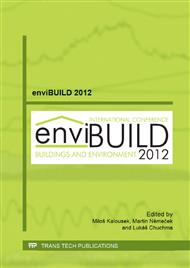p.45
p.49
p.53
p.57
p.61
p.65
p.69
p.73
p.77
Differences Ug - Values of Glazing Measured In Situ with the Influence Factors of the Internal Environment
Abstract:
This paper presented the results of experiments to determine Ug values of heat transfer coefficient on glazed window in the apartment block during heating period. For assessing the values of heat transfer coefficient of the window glazing was used heat flow measurements. Measurements are performed with optimal conditions (without the internal effects of environment) and the other hand with real conditions, when factors such as noise or artificial light affect on the construction of the glazing. Differences Ug - values is demonstrated by comparing the partial results due to transformation of noise and luminous energy from an internal environment to the heat flow in window glazing.
Info:
Periodical:
Pages:
61-64
Citation:
Online since:
January 2013
Authors:
Price:
Сopyright:
© 2013 Trans Tech Publications Ltd. All Rights Reserved
Share:
Citation:


